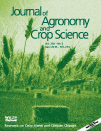View Item
- xmlui.general.dspace_homeCentros Regionales y EEAsCentro Regional Buenos Aires NorteEEA PergaminoArtículos científicosxmlui.ArtifactBrowser.ItemViewer.trail
- DSpace Home
- Centros Regionales y EEAs
- Centro Regional Buenos Aires Norte
- EEA Pergamino
- Artículos científicos
- View Item
Responses to N Deficiency in Stay Green and Non-Stay Green Argentinean Hybrids of Maize
Abstract
Breeding has developed better yielding maize hybrids for low N environments, which also have delayed leaf senescence (‘stay green’ trait, SG). Here, we studied whether the SG trait can further improve yield of modern hybrids under N-limiting conditions. In two field experiments, four maize hybrids with different senescence behaviour were grown under three N fertilization levels, from 0 to 200 kg N ha 1 (N0, N100 and N200). After silking, hybrids differed
[ver mas...]
Breeding has developed better yielding maize hybrids for low N environments, which also have delayed leaf senescence (‘stay green’ trait, SG). Here, we studied whether the SG trait can further improve yield of modern hybrids under N-limiting conditions. In two field experiments, four maize hybrids with different senescence behaviour were grown under three N fertilization levels, from 0 to 200 kg N ha 1 (N0, N100 and N200). After silking, hybrids differed for senescence depending on the canopy layer (P < 0.05): the SG AX878 only delayed senescence at the mid and upper canopy layers while the SG NK880 delayed
senescence of all layers. Across N doses, higher yields were achieved by both SG hybrids, AX878 and NK880 (P < 0.05) but yield was not only determined by senescence behaviour. Kernel weight (KW) response to N availability was larger for SGs than for their non-‘stay green’ counterparts. Delayed senescence in SG hybrids was not related to higher post-silking N uptake but to higher (P < 0.05) %N in leaves and lower (P < 0.05) %N in kernels at harvest (below the critical 1.1 % under N deficiency). Across N levels, KW positively related to N content per kernel, with a steeper slope (P < 0.05) for the SG hybrids. Taken together, our results suggest that a condition where N limits kernel growth, in a scenario of saturating C availability, may be common to stay green genotypes of maize.
[Cerrar]

Author
Antonietta, Mariana;
Acciaresi, Horacio Abel;
Guiamet, Juan José;
Fuente
Journal of agronomy and crop science 202 (3) : 231-242. (2016)
Date
2016-06
ISSN
0931-2250
Formato
pdf
Tipo de documento
artículo
Palabras Claves
Derechos de acceso
Restringido
 Excepto donde se diga explicitamente, este item se publica bajo la siguiente descripción: Creative Commons Attribution-NonCommercial-ShareAlike 2.5 Unported (CC BY-NC-SA 2.5)
Excepto donde se diga explicitamente, este item se publica bajo la siguiente descripción: Creative Commons Attribution-NonCommercial-ShareAlike 2.5 Unported (CC BY-NC-SA 2.5)

